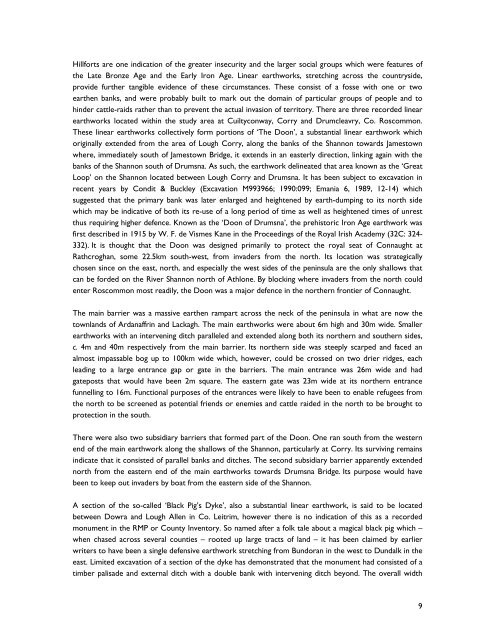archaeological & built heritage assessment - The Heritage Council
archaeological & built heritage assessment - The Heritage Council
archaeological & built heritage assessment - The Heritage Council
Create successful ePaper yourself
Turn your PDF publications into a flip-book with our unique Google optimized e-Paper software.
Hillforts are one indication of the greater insecurity and the larger social groups which were features of<br />
the Late Bronze Age and the Early Iron Age. Linear earthworks, stretching across the countryside,<br />
provide further tangible evidence of these circumstances. <strong>The</strong>se consist of a fosse with one or two<br />
earthen banks, and were probably <strong>built</strong> to mark out the domain of particular groups of people and to<br />
hinder cattle-raids rather than to prevent the actual invasion of territory. <strong>The</strong>re are three recorded linear<br />
earthworks located within the study area at Cuiltyconway, Corry and Drumcleavry, Co. Roscommon.<br />
<strong>The</strong>se linear earthworks collectively form portions of ‘<strong>The</strong> Doon’, a substantial linear earthwork which<br />
originally extended from the area of Lough Corry, along the banks of the Shannon towards Jamestown<br />
where, immediately south of Jamestown Bridge, it extends in an easterly direction, linking again with the<br />
banks of the Shannon south of Drumsna. As such, the earthwork delineated that area known as the ‘Great<br />
Loop’ on the Shannon located between Lough Corry and Drumsna. It has been subject to excavation in<br />
recent years by Condit & Buckley (Excavation M993966; 1990:099; Emania 6, 1989, 12-14) which<br />
suggested that the primary bank was later enlarged and heightened by earth-dumping to its north side<br />
which may be indicative of both its re-use of a long period of time as well as heightened times of unrest<br />
thus requiring higher defence. Known as the ‘Doon of Drumsna’, the prehistoric Iron Age earthwork was<br />
first described in 1915 by W. F. de Vismes Kane in the Proceedings of the Royal Irish Academy (32C: 324-<br />
332). It is thought that the Doon was designed primarily to protect the royal seat of Connaught at<br />
Rathcroghan, some 22.5km south-west, from invaders from the north. Its location was strategically<br />
chosen since on the east, north, and especially the west sides of the peninsula are the only shallows that<br />
can be forded on the River Shannon north of Athlone. By blocking where invaders from the north could<br />
enter Roscommon most readily, the Doon was a major defence in the northern frontier of Connaught.<br />
<strong>The</strong> main barrier was a massive earthen rampart across the neck of the peninsula in what are now the<br />
townlands of Ardanaffrin and Lackagh. <strong>The</strong> main earthworks were about 6m high and 30m wide. Smaller<br />
earthworks with an intervening ditch paralleled and extended along both its northern and southern sides,<br />
c. 4m and 40m respectively from the main barrier. Its northern side was steeply scarped and faced an<br />
almost impassable bog up to 100km wide which, however, could be crossed on two drier ridges, each<br />
leading to a large entrance gap or gate in the barriers. <strong>The</strong> main entrance was 26m wide and had<br />
gateposts that would have been 2m square. <strong>The</strong> eastern gate was 23m wide at its northern entrance<br />
funnelling to 16m. Functional purposes of the entrances were likely to have been to enable refugees from<br />
the north to be screened as potential friends or enemies and cattle raided in the north to be brought to<br />
protection in the south.<br />
<strong>The</strong>re were also two subsidiary barriers that formed part of the Doon. One ran south from the western<br />
end of the main earthwork along the shallows of the Shannon, particularly at Corry. Its surviving remains<br />
indicate that it consisted of parallel banks and ditches. <strong>The</strong> second subsidiary barrier apparently extended<br />
north from the eastern end of the main earthworks towards Drumsna Bridge. Its purpose would have<br />
been to keep out invaders by boat from the eastern side of the Shannon.<br />
A section of the so-called ‘Black Pig’s Dyke’, also a substantial linear earthwork, is said to be located<br />
between Dowra and Lough Allen in Co. Leitrim, however there is no indication of this as a recorded<br />
monument in the RMP or County Inventory. So named after a folk tale about a magical black pig which –<br />
when chased across several counties – rooted up large tracts of land – it has been claimed by earlier<br />
writers to have been a single defensive earthwork stretching from Bundoran in the west to Dundalk in the<br />
east. Limited excavation of a section of the dyke has demonstrated that the monument had consisted of a<br />
timber palisade and external ditch with a double bank with intervening ditch beyond. <strong>The</strong> overall width<br />
9
















